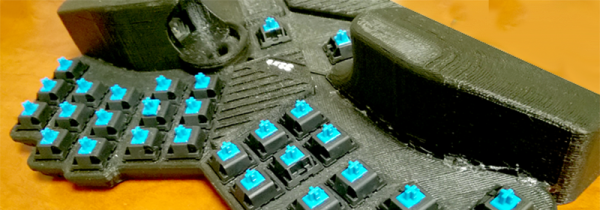There were some truly bizarre computer keyboards in the 1980s and 90s. The Maltron keyboard was a mass of injection-molded plastic with two deep dishes for all the keys. The Kinesis Advantage keyboard was likewise weird, placing the keys on the inside of a hemisphere. This was a magical time for experimentations on human-computer physical interaction, the likes of which we haven’t seen since.
Now, though, we have 3D printers, easy to use microcontrollers, and Digikey. We can make our own keyboards, and make them in any shape we want. That’s what [Andrey]’s doing. The 32XE is an ergonomic keyboard and trackball combo made for both hands.
The keyboard has curved palm rests, a trackball under the right thumb, and is powered by the ever popular DIY mechanical keyboard microcontroller, the Teensy 2.0. This keyboard is equipped with a trackball, and that means [Andrey] needed a bit of extra electronics to handle that. The mouse/trackball sensor is built around the ADNS-9800 laser motion sensor conveniently available on Tindie. This laser mouse breakout board is built into the bottom of the keyboard, with enough space above it to hold a trackball… ball.
Since this is a very strange and completely custom keyboard, normal mechanical keyboard keycaps are out of the question. Instead, [Andrey] 3D printed his own keycaps on an FDM printer. Printing keyboard keycaps on a filament-based printer is extremely difficult — the tolerances for the connector between the switch and cap are tiny, and nearly at the limit of the resolution of a desktop filament printer. [Andrey] is taking it even further with inlaid keyboard legends. He’s created a keycap set with two color legends on two sides of the keycaps. If you’ve ever wanted to print keycaps on a 3D printer, this is a project to study.











